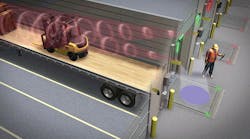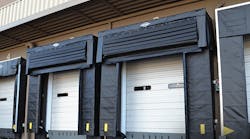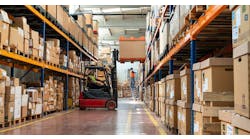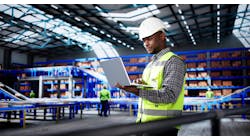Industrial facilities are inherently dangerous places, particularly around loading docks.
Accident statistics related to the two most ubiquitous pieces of equipment used in dock operations—forklifts and semi-trailers—bear this out. According to OSHA, more than 20 people are killed by semi-trucks at loading docks every year, and forklift-related fatalities occur every three days. Non-fatal forklift accidents are even more commonplace, with 94,750 reported cases per year. It is estimated that $135 million in direct costs are related to these accidents and indirect costs are likely five times that amount.
Whatever the exact cost is, it is unnecessarily high—particularly when considering that 70% of these accidents can be prevented with equipment and technology that already exists. This article will look at those technologies and specifically how they can be applied in five different areas of dock safety:
1. Trailer Separation Accidents
Despite safety improvements in the past few decades, trailer separation accidents still occur all too frequently and often result in permanent disability or even death for the workers involved. Some of the more common types of trailer separation accidents are:
Early Departure—When a truck driver unexpectedly drives away from the loading dock while a forklift operator is entering, leaving or still inside the trailer.
Trailer Creep—In some cases, the repeated jarring made by the forklift traffic can cause the trailer to edge away from the dock, ultimately causing the lift truck to fall.
Landing Gear Collapse—The landing gear on a trailer may also give way, causing the trailer to pitch forward or fall to the side.
Trailer Pop-Up—A loaded forklift entering the rear of the trailer may cause it to move forward and drop, making the nose of the trailer suddenly rise.
Trailer Upending—The reverse of trailer pop-up, this occurs when weight of the forklift sends the trailer’s nose down, causing the rear end to move up and away from the building.
In the 1980s and 1990s, most shipments were on standard 45-foot to 53-foot over-the-road trailers. Preventing these types of accidents was fairly straightforward with rotating-hook trailer restraints, which were considered a state-of-the-art tool for securing trailers at the dock. While OTR trailers are still prevalent across roads and at loading docks in the U.S., “non-traditional” rigs have increased dramatically in recent years—including trucks and trailers with hydraulic tailgates and refrigerated trailers on back hauls. Perhaps most dramatic has been the increase in the number of intermodal cargo containers on intermodal chassis, a category whose growth is expected to double that of traditional OTR trailers in the next decade.
These different trailer configurations create a new set of challenges for securing shipments and there is no longer a one-size-fits-all trailer restraint solution for most facilities. While “shadow-hook” restraints (which can handle intermodal chassis and a wider range of trailers) are an important step forward, even they don’t work in all situations. In some cases, specialized stabilizing trailer restraint units may be needed to provide additional stability, while wheel-based restraints can provide a better fit for lift-gate trailers and tankers.
No matter what type of restraint is used, the key to safety at the loading dock is proper and constant communication. Generally speaking, this is done with lights on the inside and outside of the loading dock. Recent advancements in this technology include status-at-a-glance indicators in the corners of the dock opening and on the leveler. Additional advancements will be discussed below.
2. Protecting Pedestrians from Falls at the Loading Dock
Falls from loading dock openings are one of the most common types of forklift accidents. In fact, they account for 7% of all reported forklift accidents. Considering most of these falls are in excess of 4 feet, the damage to equipment, product and workers can be catastrophic.
Many facility managers are probably well aware of OSHA guide 1910.23, which stated every wall opening from which there is a drop-off of more than 4 feet shall be guarded by one of the following: rail, roller, picket fence, half door, or equivalent barrier.
Recently, however, OSHA updated this old standard when it passed a regulation that specifically calls for a guard rail or equivalent barrier. Loading dock chains are no longer compliant with OSHA. Moving forward, it is critical that facilities that carry an open dock door policy adequately protect these dangerous openings. It’s a topic that will continue to gain attention in the coming years.
3. Improve Pedestrian Safety
Of the approximately 60 loading dock-related deaths in the last three years, 60% of them have involved a worker on the drive approach being crushed by a backing trailer. On the inside of the dock, about 53% of forklift fatalities were the result of workers being struck or crushed by a forklift.
To address these dangers, a number of new safety products have been introduced. For example, some vehicle restraints now incorporate an external motion sensor, which triggers an audible and visual alarm to alert workers outside the dock when a trailer begins backing in.
Motion-sensor based safety systems are also becoming popular inside the dock area. One system projects a blue light (similar to forklift safety lights) when activity is detected inside a trailer, alerting workers that a forklift could back out at any moment.
4. Reduce Whole Body Vibration
Forklifts are not comfortable to drive. With tires often made from solid rubber and no suspension system to speak of, they deliver an extremely stiff ride. Any bump or hump exacerbates this, by exerting pressure through the bottom of the forklift up a driver’s spine and into the shoulders and neck. Not surprisingly, more than one in five forklift drivers suffer from back and/or neck injuries.
Old dock levelers are one of the most common catalysts for this. Because of their bumps and gaps, a forklift driver crossing over a leveler between warehouse and trailer may experience a jarring, whole body vibration known as “dock shock.” The first vibration point is typically located where the dock plate meets the warehouse floor, while a second occurs when the lift truck passes over the raised crown of the leveler’s front lip hinge.
By creating smoother transitions from leveler to trailer (and vice-versa), more ergonomically-designed levelers can alleviate this, reducing dock shock by up to 50%. Minimizing dock shock not only enhances employee well-being, it also reduces damage to dock equipment, forklifts and the products those forklifts carry.
5. Implementing a Safe Sequence of Operation
Considering all of these dangers, it can be difficult to keep everything straight during every trailer loading and unloading. Whether it’s human error or dock workers short-cutting safety steps to be more efficient, operational mistakes can lead to injuries and death.
Fortunately, technology exists to interlock all of these types of loading dock safety equipment (like vehicle restraints, levelers and loading dock doors) on one control panel to ensure a safe sequence of operation. For example, advanced dock control systems can be programmed with a green light interlock, which disables the use of the hydraulic leveler or overhead door until the vehicle restraint is safely engaged; an overhead door interlock, which requires overhead doors to be opened prior to leveler operation; or a stored leveler interlock, which ensures that the leveler is stored safely before the restraint can release the trailer. If an inexperienced worker presses the control box button for an individual system element in the wrong sequence, it won’t work. This control box helps ensure that no safety procedures will be skipped.
Loading Dock Safety
With heavy equipment moving continually both inside and out, loading docks are among the most dangerous places in any industrial operation. While it will never be possible for facility managers to eliminate human error entirely, it is possible for them to dramatically enhance the safety equipment and protocols that protect dock workers, minimize their risks and maximize overall efficiency.
The information herein is provided without warranty. It is your responsibility to ensure that you are using all mentioned products properly in your specific application and in accordance with all laws and regulations.
Walt Swietlik is director of customer relations and sales support for Rite-Hite, a manufacturer of loading dock equipment.




